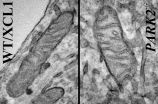(Press-News.org) CAMBRIDGE, Mass. (April 2, 2015) - A team of Whitehead Institute scientists has discovered that during division, stem cells distinguish between old and young mitochondria and allocate them disproportionately between daughter cells. As a result, the daughter cell destined to remain a stem cell receives predominantly young mitochondria, while the cell meant to differentiate into another cell type carries with it a higher compliment of the aged organelles.
This asymmetric apportioning of cellular contents may represent a mechanism through which stem cells prevent the accumulation of damage in their lineage over time.
"There is a fitness advantage to renewing your mitochondria," says Whitehead Member David Sabatini, whose lab reports on the phenomenon online this week in the journal Science. "Stem cells know this and have figured out a way to discard their older components."
Among the hallmarks of stem cells is so-called asymmetric cell division. Unlike their ordinary cellular counterparts, which divide symmetrically to create two cells with identical fates, stem cell division can produce one daughter cell that will remain a stem cell and another bound for further differentiation into another cell type. Scientists have observed that non-mammalian organisms are able to apportion damaged components asymmetrically during cell division, but it was unclear whether mammalian stem cells could behave similarly.
To answer this question, scientists in Sabatini's lab studied stem-like cells (SLCs) from cultures of immortalized human mammary epithelial cells. These SLCs were chosen because they express genes associated with the stem-cell state (referred to as stemness), are able to form structures known as mammospheres in culture. To track the destinations of subcellular components during cell division, the researchers, led by former postdoctoral scientist Pekka Katajisto, tagged the components--including lysosomes, mitochondria, Golgi apparatus, ribosomes, and chromatin--with a fluorescent protein that glows when hit by a pulse of ultraviolet light.
By tracing the movements of the glowing organelles, the researchers were able to demonstrate that while the normal epithelial cells distributed all of the tagged components symmetrically to daughter cells, the SLCs localized their older mitochondria distinctly and passed on the lion's share of them to the daughter cells headed for differentiation. The researchers ultimately found that the number of older mitochondria in those cells was roughly six times that in daughter cells whose fate was to remain as stem cells.
In a series of additional experiments, the scientists found that cells that inherited fewer old mitochondria during asymmetric division formed three times the number of mammospheres per 1000 cells than the daughter cells inheriting a greater proportion old mitochondria. This was an indication that cells with fewer of these old organelles were, by the mammosphere-forming criterion, more stem-like. Further, they discovered that chemically disrupting the cells' inherent mitochondrial quality-control mechanisms prevented asymmetric apportioning of young and old mitochondria and caused the loss of stem-like characteristics. Taken together, these results indicate that this disproportionate allocation of aged mitochondria during stem cell division is essential for maintaining stemness in the next generation.
"While we do not know how stem cells recognize the age of their mitochondria, forced symmetric apportioning of aged mitochondria resulted in loss of stemness in all of the daughter cells," says Katajisto, the first author of the Science paper who now runs a lab at the Institute of Biotechnology at University of Helsinki. "This suggests that the age-selective apportioning of old and potentially damaged organelles may be a way to fight stem cell exhaustion and aging."
Katajisto is now exploring whether this phenomenon occurs in other cell types beyond the human mammary epithelial SLCs examined here as well as in in vivo studies.
INFORMATION:
This work was supported by the National Institutes of Health (grant CA103866), Foundations' Post Doc Pool, Academy of Finland, and Marie Curie Actions.
David Sabatini's primary affiliation is with Whitehead Institute for Biomedical Research, where his laboratory is located and all his research is conducted. He is also a Howard Hughes Medical Institute investigator and a professor of biology at Massachusetts Institute of Technology.
Full Citation:
"Asymmetric apportioning of aged mitochondria between daughter cells is required for stemness"
Science, April 2, 2015 (online edition)
Pekka Katajisto (1,2,3), Julia Döhla (3), Christine Chaffer (1), Nalle Pentinmikko (3), Nemanja Marjanovic (1), Sharif Iqbal (3), Roberto Zoncu (1,2), Walter Chen (1,2), Robert A. Weinberg (1), David M. Sabatini (1,2)
1. Whitehead Institute for Biomedical Research, Boston, MA 02142 USA; Department of Biology, MIT, Cambridge, MA 02139, USA
2. Howard Hughes Medical Institute, MIT, Cambridge, MA 02139, USA
3. Institute of Biotechnology, University of Helsinki, P.O. box 00014, Helsinki, Finland
Characteristics passed between generations are not decided solely by DNA, but can be brought about by other material in cells, new research shows.
Scientists studied proteins found in cells, known as histones, which are not part of the genetic code, but act as spools around which DNA is wound. Histones are known to control whether or not genes are switched on.
Researchers found that naturally occurring changes to these proteins, which affect how they control genes, can be sustained from one generation to the next and so influence which traits are passed on.
The finding ...
Variations in the color of grapevine berries within the Pinot family result from naturally-occurring genetic mutations that selectively shut down the genes responsible for the synthesis of red pigments, called anthocyanins. This has led to the emergence of Pinot blanc and Pinot gris from Pinot noir. Frédérique Pelsy and her colleagues, from the "Grapevine Health and Wine Quality" research unit at INRA Colmar, France, published these findings in PLOS Genetics on 2 April 2015.
The vine stocks used in viticulture are obtained by grafting; therefore, for any given ...
Infants have innate knowledge about the world and when their expectations are defied, they learn best, researchers at Johns Hopkins University found.
In a paper to be published April 3 in the journal Science, cognitive psychologists Aimee E. Stahl and Lisa Feigenson demonstrate for the first time that babies learn new things by leveraging the core information they are born with. When something surprises a baby, like an object not behaving the way a baby expects it to, the baby not only focuses on that object, but ultimately learns more about it than from a similar yet ...
French physicist Jean Charles Athanase Peltier discovered a key concept necessary for thermoelectric (TE) temperature control in 1834. His findings were so significant, TE devices are now commonly referred to Peltier devices. Since his work, there have been steady advancements in materials and design. Despite the technological sophistication Peltier devices, they are still less energy efficient than traditional compressor/evaporation cooling.
In the 1960's, Peltier devices were primarily made from Bismuth-Telluride (Bi2Te3) or Antimony-Telluride (Sb2Te3) alloys and ...
MIAMI - A first-of-its-kind study observed how oil droplets are formed and measured their size under high pressure. They further simulated how the atomized oil spewing from the Macondo well reached the ocean's surface during the Deepwater Horizon accident. The findings from the University of Miami (UM) Rosenstiel School of Marine and Atmospheric Science and University of Western Australia research team suggest that the physical properties in deep water create a natural dispersion mechanism for oil droplets that generates a similar effect to the application of chemical ...
Binge-drinking during adolescence may perturb brain development at a critical time and leave lasting effects on genes and behavior that persist into adulthood.
The findings, by researchers at the University of Illinois at Chicago College of Medicine using an animal model, are reported online in the journal Neurobiology of Disease.
"This may be the mechanism through which adolescent binge-drinking increases the risk for psychiatric disorders, including alcoholism, in adulthood," says lead author Subhash Pandey, professor of psychiatry and director of neuroscience alcoholism ...
Irvine, Calif. -- A newly developed website provides parents and children with individualized information and support -- based on factors like coping style and levels of worry and fear -- to help lower anxiety before outpatient surgery in children, according to a pair of articles in the April issue of Anesthesia & Analgesia.
The papers report on the development of the "Web-based Tailored Intervention Preparation for Surgery" (WebTIPS) project, which provides information and strategies to help children and parents prepare for surgery and anesthesia. A preliminary evaluation ...
Based on research in fruit flies, it has long been suspected that the most common mutation linked to both sporadic and familial Parkinson's disease (PD) wreaks its havoc by altering the function of mitochondria in neurons that produce the neurotransmitter dopamine. Using stem cells derived from patients who have PD, scientist at the Buck Institute have confirmed that finding in human cells for the first time. In research published in the April 2nd early online edition of Stem Cell Reports, Buck researchers also provide a valuable tool for testing potential treatments ...
BOSTON -- Pseudogenes, a sub-class of long non-coding RNA (lncRNA) that developed from the genome's 20,000 protein-coding genes but lost the ability to produce proteins, have long been considered nothing more than genomic "junk." Yet the retention of these 20,000 mysterious remnants during evolution has suggested that they may in fact possess biological functions and contribute to the development of disease.
Now, a team led by investigators in the Cancer Research Institute at Beth Israel Deaconess Medical Center (BIDMC) has provided some of the first evidence that one ...
The ability to learn associations between events is critical for survival, but it has not been clear how different pieces of information stored in memory may be linked together by populations of neurons. In a study published April 2nd in Cell Reports, synchronous activation of distinct neuronal ensembles caused mice to artificially associate the memory of a foot shock with the unrelated memory of exploring a safe environment, triggering an increase in fear-related behavior when the mice were re-exposed to the non-threatening environment. The findings suggest that co-activated ...


